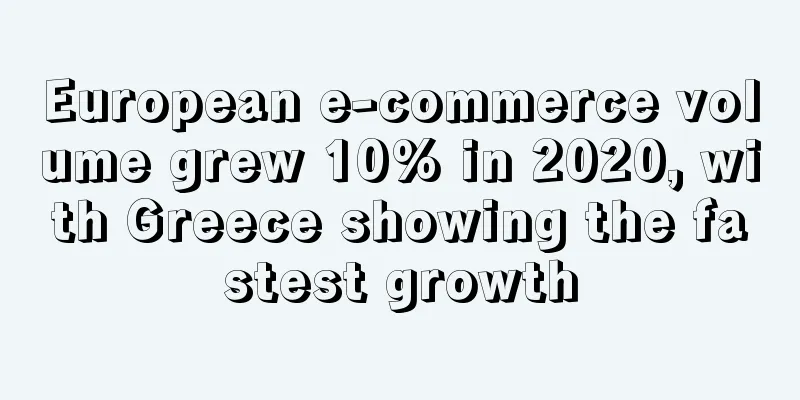European e-commerce volume grew 10% in 2020, with Greece showing the fastest growth

|
Last year, the highest growth rate in European e-commerce turnover was recorded in Greece ( 77% ), as reflected in the 2021 European E-commerce Report jointly released by the Hellenic E-commerce Association, the European E-commerce Association and the European Business Association .
According to the report , the total value of European e-commerce in 2020 increased from 690 billion euros in 2019 to 757 billion euros, an increase of 10% , but a slight decrease compared with 2019 (14%). The epidemic has greatly promoted the development of e-commerce , but the sharp decline in online sales in industries such as tourism and services has made the growth rate relatively stable.
According to research, the epidemic has had a huge impact on the development of the retail industry , and the lockdown has accelerated the current transformation of stores to digitalization and greening . E-commerce is the lifeline of consumers who are unable to buy what they need in stores due to policy restrictions such as government lockdowns .
While e-commerce has not completely offset the losses suffered by SMEs’ physical stores , it has absorbed much of the financial shock. However, further work is needed to ensure that the retail industry can fully leverage digital transformation to move into new markets.
The report shows that Western Europe is the strongest region in terms of B2C e-commerce turnover, accounting for 64% of total turnover in 2020. Southern Europe comes in second with just 16% of total turnover, while Central Europe (8%) and Northern and Eastern Europe (both 6%) come in third.
The leaders in B2C e-commerce turnover remain the United Kingdom ( 236 billion euros ) , France ( 11.2 billion euros ), Germany ( 93.6 billion euros ) and Spain ( 68.4 billion euros ) . However, the highest growth rates in e-commerce turnover were recorded in Greece ( 77% ) , Moldova ( 49% ) , Russia ( 41% ) , Switzerland , North Macedonia ( 37% ) and Sweden ( 36% ).
In addition , Internet usage in Europe increased from 87% in 2019 and 85% in 2018 to 89% in 2020, including Western Europe (95%). The number of online shoppers grew faster in 2020 than in the previous four years, with 71% having purchased something in an online store ( 66% in 2019 and 64% in 2018 ).
Western Europe has the highest percentage of online shoppers ( 86% ) , followed by the Nordics ( 82%). The UK has the highest percentage of online shoppers ( 92%), followed by the Netherlands (91%), Denmark and Switzerland (90%), Germany and Norway (87%), and Sweden (86%).
The countries with the lowest percentage of online shoppers are Moldova ( 34%), Albania (37%), Ukraine and North Macedonia (40%), Bulgaria (42%) and finally Russia (43%). Independent website |
<<: Record-breaking! 97 cargo ships waiting to enter the ports of Los Angeles and Long Beach
>>: Due to the surge in demand for daily necessities, Costco has started purchasing restrictions!
Recommend
What is Youhong Supply Chain? Youhong Supply Chain Review, Features
Youhong Supply Chain specializes in providing Sou...
The global sleepwear industry will be worth more than $18 billion in 2027
Recently, market research firm NPD Group said: In...
What is Shenzhen Mengbang Import and Export Supply Chain Co., Ltd.? Shenzhen Mengbang Import and Export Supply Chain Co., Ltd. Review, Features
Shenzhen Mengbang Import and Export Supply Chain C...
What is hbleatherfactory? hbleatherfactory Review, Features
Hbleatherfactory is a designer, manufacturer and d...
There are major changes to FBA inventory restrictions, involving these two major sites!
FBA limited inventory has been updated again! Sin...
Counting COVID-19 patients by hand? Japan's operation shocked everyone
According to foreign media reports, on the 17th ,...
Amazon's latest policy! Nearly 450,000 ASINs will be removed
On the Amazon platform, products are often remove...
What is Oars+Alps? Oars+Alps Review, Features
Oars + Alps is an American men's sportswear, ...
Will the demand for “halal shoes” in the European and American markets see an explosion?
In Europe and North America, "Halal shoes&qu...
What is Holy Stone? Holy Stone Review, Features
Holy Stone was founded in 2014. In just a few year...
Russian cross-border giants reduce commissions for "hundred-dollar products"! 80% of products will benefit
Yesterday, Ozon, one of Russia's largest cros...
AliExpress Double 11 sales are booming, merchants say: orders can't stop
“ The stock was sold out in one hour ?” At 5pm on...
The EU e-commerce penetration rate is as high as 72%, with the Netherlands ranking first
It is reported that recently, a survey conducted ...
UK Boxing Day sales expected to plummet
Boxing Day , which falls on December 26th every y...
Amazon is going to charge again, and sellers’ operating costs are soaring again!
Another day of mixed joys and sorrows! As Amazon&...









